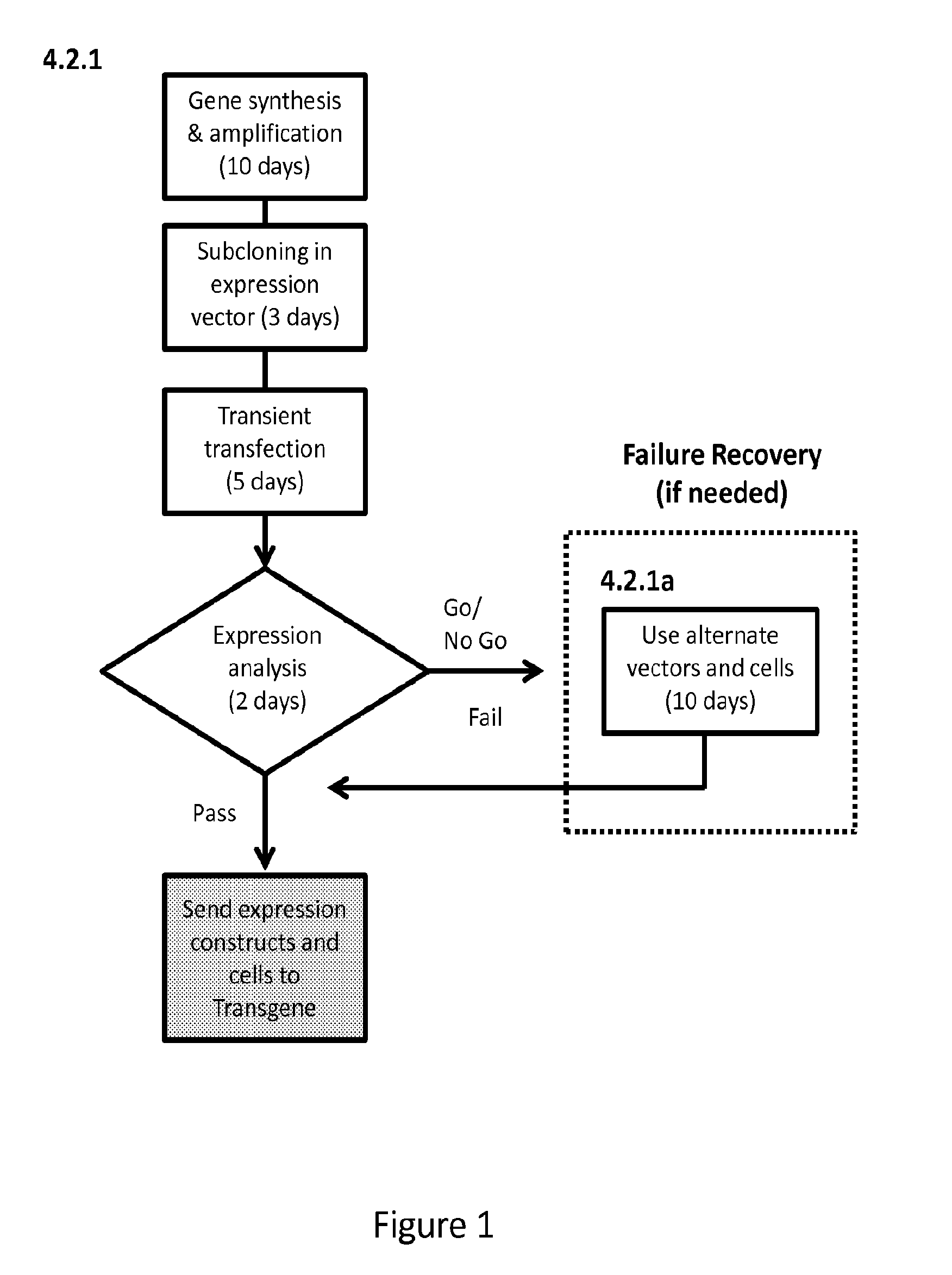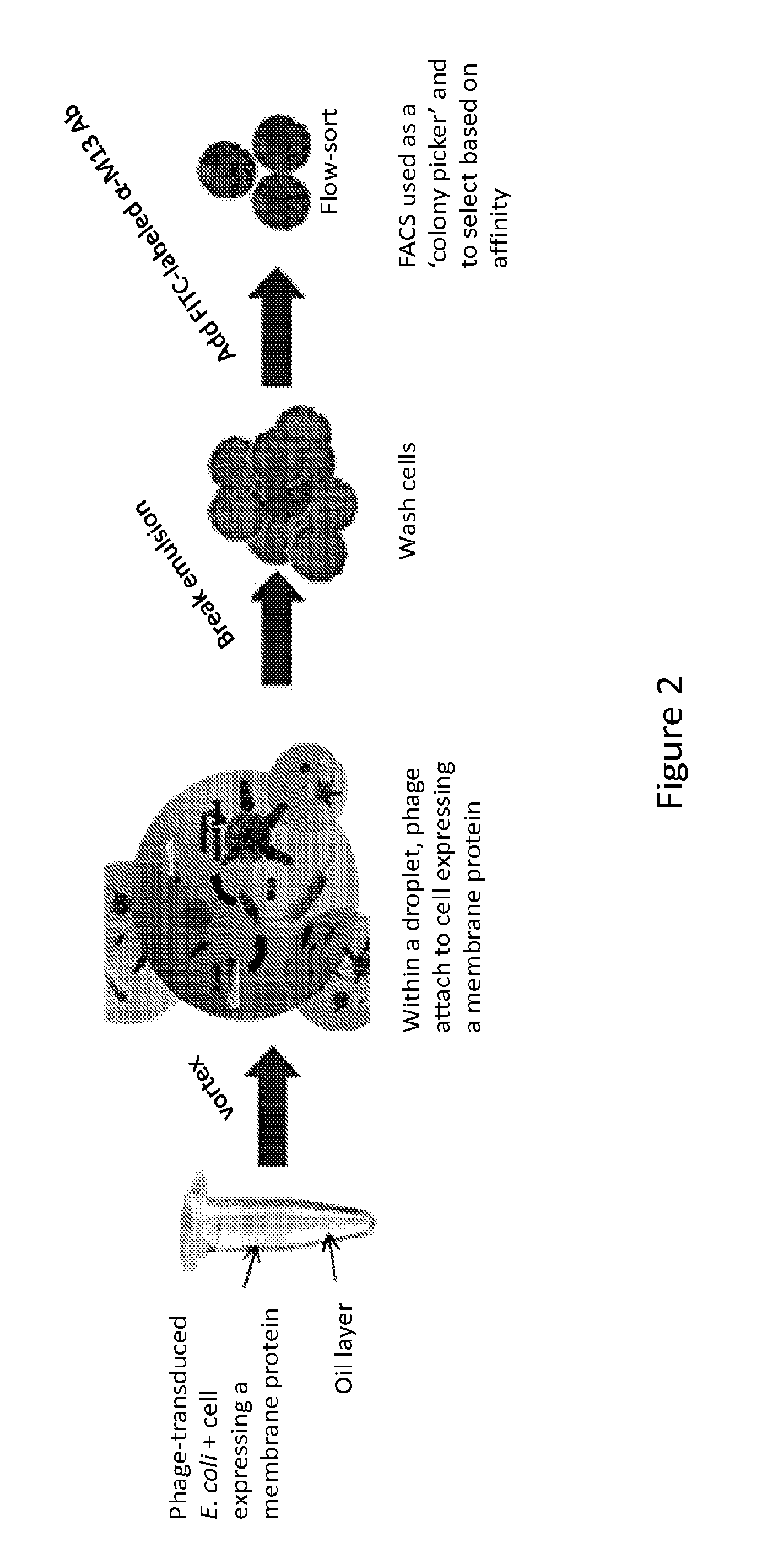Compositions and methods for the identification and isolation of cell-membrane protein specific binding moieties
a cell-membrane protein and specific binding technology, applied in the field of cell-based biopanning approaches, can solve the problems of difficult to obtain antibodies against membrane proteins, methods that may not be directly applicable to some antigens, and conventional cell-based biopanning approaches can suffer from several limitations
- Summary
- Abstract
- Description
- Claims
- Application Information
AI Technical Summary
Benefits of technology
Problems solved by technology
Method used
Image
Examples
example 1
Screening an scFv Phage Library by Biopanning Against Whole Cells in a Micro-Emulsion
[0076]We have previously developed an approach utilizing water-in-oil emulsion to isolate cells secreting phage particles that display desirable scFvs (Buhr et al., 2012. Use of micro-emulsion technology for the directed evolution of antibodies. Methods 58: 28-33). In this previously developed method, a large library of antibody-displaying phage will bind to antigen-coated beads in individual compartments. The methods of the present invention further provide a micro-emulsion approach to biopanning phage against whole cells, e.g., 293-F cells over-expressing the integral membrane protein Slc7A11 (xCT). Significantly, the present invention features biopanning against cells displaying membrane protein antigens, rather than biopanning against antigen-coated beads. Rather than biopanning a large, mixed population in bulk, present methods allow individually querying of clonal populations of phage against ...
example 2
Preparation and Validation of Target Antigens
[0078]The methods of the present invention are applied to the identification of scFv binding moieties capable of binding the integral membrane protein Slc7A11 (xCT). xCT is the core subunit of the dimeric system xc− high affinity cysteine transporter, which belongs to a family of heteromeric amino acid transporters (HATs). These transporters are composed of a heavy subunit and a light subunit coupled via a disulfide bridge. The heavy subunit is involved in trafficking the heterodimer to the plasma membrane, while the light subunit confers transport and substrate specificity. xCT is a light chain subunit, while the heavy chain subunit of system xc− is 4F2hc, which is highly glycosylated. xCT proteins are identified, e.g., in humans, macaques, and mice. In the present example, scFv binding moieties that recognize different epitopes of the displayed portion(s) of xCT are generated.
[0079]Because xCT is a 12 transmembrane domain protein with N...
example 3
Screening of Human scFv Library by Whole Cell Phage Biopanning in Micro-Emulsions
[0086]A micro-emulsion approach is used in whole cell phage biopanning to screen for binding moieties capable of binding 293-F cells over-expressing xCT. In our previous studies using water-in-oil emulsion methods (Buhr et al., 2012. Use of micro-emulsion technology for the directed evolution of antibodies. Methods 58: 28-33), a large library of antibody-displaying phage was contacted with antigen-coated beads in individual compartments. The method allows clonal populations of amplified phage to be individually queried against selected antigens with subsequent identification of cognate binding moieties by Fluorescence Activated Cell Sorting (FACS). Here, the antigen-coated bead of our previous studies is replaced with an antigen carrier of the present invention (FIG. 2).
[0087]The biopanning for cognate binding moieties of xCT will utilize an emulsion. Emulsions are provide certain advantages in biopanni...
PUM
| Property | Measurement | Unit |
|---|---|---|
| temperature | aaaaa | aaaaa |
| diameter | aaaaa | aaaaa |
| fluorescent | aaaaa | aaaaa |
Abstract
Description
Claims
Application Information
 Login to View More
Login to View More - R&D
- Intellectual Property
- Life Sciences
- Materials
- Tech Scout
- Unparalleled Data Quality
- Higher Quality Content
- 60% Fewer Hallucinations
Browse by: Latest US Patents, China's latest patents, Technical Efficacy Thesaurus, Application Domain, Technology Topic, Popular Technical Reports.
© 2025 PatSnap. All rights reserved.Legal|Privacy policy|Modern Slavery Act Transparency Statement|Sitemap|About US| Contact US: help@patsnap.com



